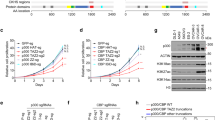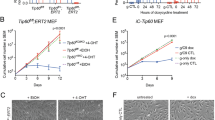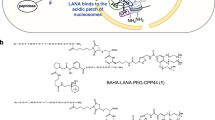Abstract
pp32 belongs to a family of leucine-rich acidic nuclear proteins, which play important roles in many cellular processes including regulation of chromatin remodeling, transcription, RNA transport, transformation and apoptosis. pp32 is described as a new tumor suppressor. It is unknown as to how pp32 works in tumor suppression. We found that overexpression of pp32 in human Jurkat T cells inhibits cell growth, and silenced pp32 promotes growth. We first showed that hyperacetylation and hyperphosphorylation of histone H3 are required for T-cell activation. Phosphorylation of histone H3 precedes acetylation during T-cell activation. pp32 specifically binds to histone H3 and blocks its acetylation and phosphorylation. pp32 directly initiates caspase activity and also promotes granzyme A-mediated caspase-independent cell death. Taken together, pp32 plays a repressive role by inhibiting transcription and triggering apoptosis.
Similar content being viewed by others
Log in or create a free account to read this content
Gain free access to this article, as well as selected content from this journal and more on nature.com
or
Abbreviations
- aa:
-
amino acid
- ChIP:
-
chromatin immunoprecipitation
- CRE:
-
cAMP-response element
- EGF:
-
epidermal growth factor
- ER:
-
endoplasmic reticulum
- GFP:
-
green fluorescent protein
- Gzm:
-
granzyme
- HAT:
-
histone acetyltransferase
- IE:
-
immediate-early
- IL-2:
-
interleukin 2
- Lys:
-
lysine
- MAPK:
-
mitogen-activated protein kinase
- NAP:
-
nucleosome assembly protein
- PCAF:
-
p300/CBP-associated factor
- PFP:
-
pore-forming protein
- pI:
-
isoelectric point
- PKC:
-
protein kinase C
- PMA:
-
phorbol myristate acetate
- PP2A:
-
protein phosphatase 2A
- RNAi:
-
RNA interference
- Ser:
-
serine
References
Kadkol SS, Brody JR, Pevsner J, Bai J and Pasternack GR (1999) Modulation of oncogenic potential by alternative gene use in human prostate cancer. Nat. Med. 5: 275–279
Malek SN, Katumuluwa AI and Pasternack GR (1990) Identification and preliminary characterization of two related proliferation-associated nuclear phosphoproteins. J. Biol. Chem. 265: 13400–13409
Fukuda M, Asano S, Nakamura T, Adachi M, Yoshida M, Yanagida M and Nishida E (1997) CRM1 is responsible for intracellular transport mediated by the nuclear export signal. Nature 390: 308–311
Brody JR, Kadkol SS, Mahmoud MA, Rebel JM and Pasternack GR (1999) Identification of sequences required for inhibition of oncogene-mediated transformation by pp32. J. Biol. Chem. 274: 20053–20055
Li M, Makkinje A and Damuni Z (1996) Molecular identification of I1PP2A, a novel potent heat-stable inhibitor protein of protein phosphatase 2A. Biochemistry 35: 6998–7002
Seo SB, McNamara P, Heo S, Turner A, Lane WS and Chakravarti D (2001) Regulation of histone acetylation and transcription by INHAT, a human cellular complex containing the set oncoprotein. Cell 104: 119–130
Fujii-Nakata T, Ishimi Y, Okuda A and Kikuchi A (1992) Functional analysis of nucleosome assembly protein, NAP-1. The negatively charged COOH-terminal region is not necessary for the intrinsic assembly activity. J. Biol. Chem. 267: 20980–20986
Shikama N, Chan HM, Krstic-Demonacos M, Smith L, Lee CW, Cairns W and La Thangue NB (2000) Functional interaction between nucleosome assembly proteins and p300/CREB-binding protein family coactivators. Mol. Cell. Biol. 20: 8933–8943
Fischle W, Wang Y and Allis CD (2003) Histone and chromatin cross-talk. Curr. Opin. Cell Biol. 15: 172–183
Strahl BD and Allis CD (2000) The language of covalent histone modifications. Nature 403: 41–45
Grunstein M (1997) Histone acetylation in chromatin structure and transcription. Nature 389: 349–352
Cheung P, Tanner KG, Cheung WL, Sassone-Corsi P, Denu JM and Allis CD (2000) Synergistic coupling of histone H3 phosphorylation and acetylation in response to epidermal growth factor stimulation. Mol. Cell 5: 905–915
Wei Y, Yu L, Bowen J, Gorovsky MA and Allis CD (1999) Phosphorylation of histone H3 is required for proper chromosome condensation and segregation. Cell 97: 99–109
Thomson S, Mahadevan LC and Clayton AL (1999) MAP kinase-mediated signalling to nucleosomes and immediate-early gene induction. Semin. Cell Dev. Biol. 10: 205–214
Dunn KL and Davie JR (2005) Stimulation of the Ras-MAPK pathway leads to independent phosphorylation of histone H3 on serine 10 and 28. Oncogene 24: 3492–3502
Lieberman J and Fan Z (2003) Nuclear war: the granzyme A-bomb. Curr. Opin. Immunol. 15: 553–559
Fan Z, Beresford PJ, Oh DY, Zhang D and Lieberman J (2003) Tumor suppressor NM23-H1 is a granzyme A-activated DNase during CTL-mediated apoptosis, and the nucleosome assembly protein SET is its inhibitor. Cell 112: 659–672
Beresford PJ, Xia Z, Greenberg AH and Lieberman J (1999) Granzyme A loading induces rapid cytolysis and a novel form of DNA damage independently of caspase activation. Immunity 10: 585–594
Beresford PJ, Zhang D, Oh DY, Fan Z, Greer EL, Russo ML, Jaju M and Lieberman J (2001) Granzyme A activates an endoplasmic reticulum-associated caspase-independent nuclease to induce single-stranded DNA nicks. J. Biol. Chem. 276: 43285–43293
Jiang X, Kim HE, Shu H, Zhao Y, Zhang H, Kofron J, Donnelly J, Burns D, Ng SC, Rosenberg S and Wang X (2003) Distinctive roles of PHAP proteins and prothymosin-alpha in a death regulatory pathway. Science 299: 223–226
Fyodorov DV and Kadonaga JT (2001) The many faces of chromatin remodeling: SWItching beyond transcription. Cell 106: 523–525
Struhl K (1999) Fundamentally different logic of gene regulation in eukaryotes and prokaryotes. Cell 98: 1–4
Seo SB, Macfarlan T, McNamara P, Hong R, Mukai Y, Heo S and Chakravarti D (2002) Regulation of histone acetylation and transcription by nuclear protein pp32, a subunit of the INHAT complex. J. Biol. Chem. 277: 14005–14010
Rothenberg EV and Ward SB (1996) A dynamic assembly of diverse transcription factors integrates activation and cell-type information for interleukin 2 gene regulation. Proc. Natl. Acad. Sci. USA 93: 9358–9365
Tenbrock K, Juang YT, Tolnay M and Tsokos GC (2003) The cyclic adenosine 5′-monophosphate response element modulator suppresses IL-2 production in stimulated T cells by a chromatin-dependent mechanism. J. Immunol. 170: 2971–2976
Grewal SI and Moazed D (2003) Heterochromatin and epigenetic control of gene expression. Science 301: 798–802
Brody JR, Kadkol SS, Hauer MC, Rajaii F, Lee J and Pasternack GR (2004) pp32 reduction induces differentiation of TSU-Pr1 cells. Am. J. Pathol. 164: 273–283
Kadkol SS, Brody JR, Epstein JI, Kuhajda FP and Pasternack GR (1998) Novel nuclear phosphoprotein pp32 is highly expressed in intermediate- and high-grade prostate cancer. Prostate 34: 231–237
Adegbola O and Pasternack GR (2005) Phosphorylated retinoblastoma protein complexes with pp32 and inhibits pp32-mediated apoptosis. J. Biol. Chem. 280: 15497–15502
Chau BN and Wang JY (2003) Coordinated regulation of life and death by RB. Nat. Rev. Cancer 3: 130–138
Thomson S, Clayton AL and Mahadevan LC (2001) Independent dynamic regulation of histone phosphorylation and acetylation during immediate-early gene induction. Mol. Cell. 8: 1231–1241
Matilla A, Koshy BT, Cummings CJ, Isobe T, Orr HT and Zoghbi HY (1997) The cerebellar leucine-rich acidic nuclear protein interacts with ataxin-1. Nature 389: 974–978
Matsuoka K, Taoka M, Satozawa N, Nakayama H, Ichimura T, Takahashi N, Yamakuni T, Song SY and Isobe T (1994) A nuclear factor containing the leucine-rich repeats expressed in murine cerebellar neurons. Proc. Natl. Acad. Sci. USA 91: 9670–9674
Walensky LD, Coffey DS, Chen TH, Wu TC and Pasternack GR (1993) A novel M(r) 32 000 nuclear phosphoprotein is selectively expressed in cells competent for self-renewal. Cancer Res. 53: 4720–4726
Opal P, Garcia JJ, McCall AE, Xu B, Weeber EJ, Sweatt JD, Orr HT and Zoghbi HY (2004) Generation and characterization of LANP/pp32 null mice. Mol. Cell. Biol. 24: 3140–3149
Fan Z, Beresford PJ, Zhang D and Lieberman J (2002) HMG2 interacts with the nucleosome assembly protein SET and is a target of the cytotoxic T-lymphocyte protease granzyme A. Mol. Cell. Biol. 22: 2810–2820
Fan Z, Beresford PJ, Zhang D, Xu Z, Novina CD, Yoshida A, Pommier Y and Lieberman J (2003) Cleaving the oxidative repair protein Ape1 enhances cell death mediated by granzyme A. Nat. Immunol. 4: 145–153
Acknowledgements
We thank Dr Lieberman for the helpful discussion and for providing some reagents. This work was supported by the National Science Foundation Committee Grant 30470365 (to ZF).
Author information
Authors and Affiliations
Corresponding author
Additional information
Edited by RA Knight
Rights and permissions
About this article
Cite this article
Fan, Z., Zhang, H. & Zhang, Q. Tumor suppressor pp32 represses cell growth through inhibition of transcription by blocking acetylation and phosphorylation of histone H3 and initiating its proapoptotic activity. Cell Death Differ 13, 1485–1494 (2006). https://doi.org/10.1038/sj.cdd.4401825
Received:
Revised:
Accepted:
Published:
Issue date:
DOI: https://doi.org/10.1038/sj.cdd.4401825



